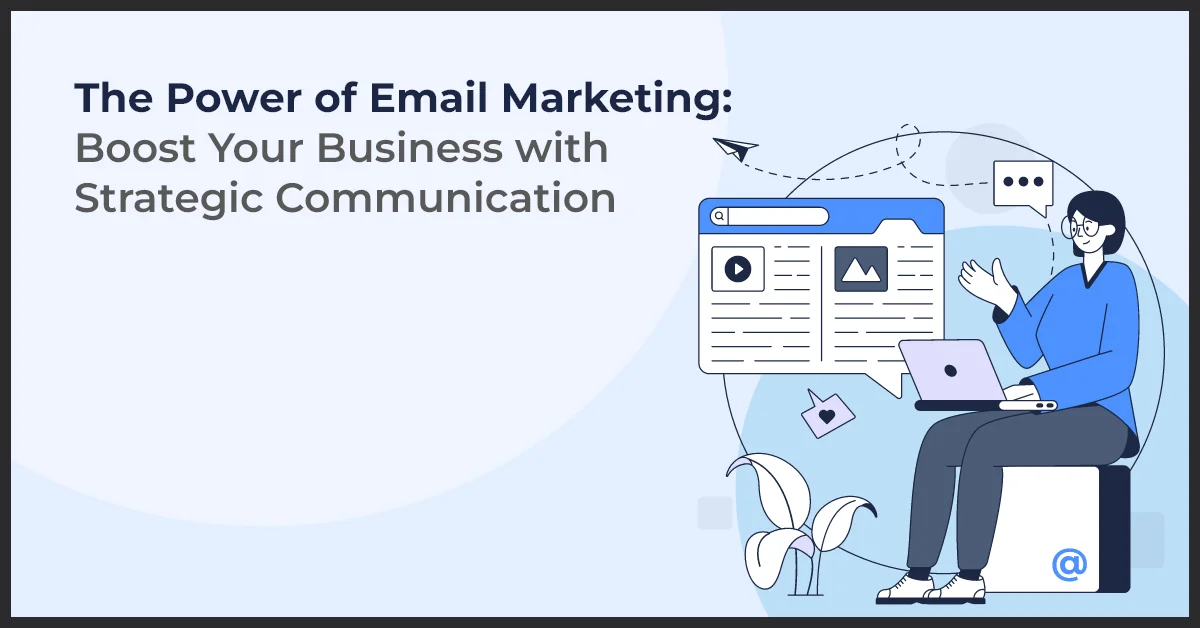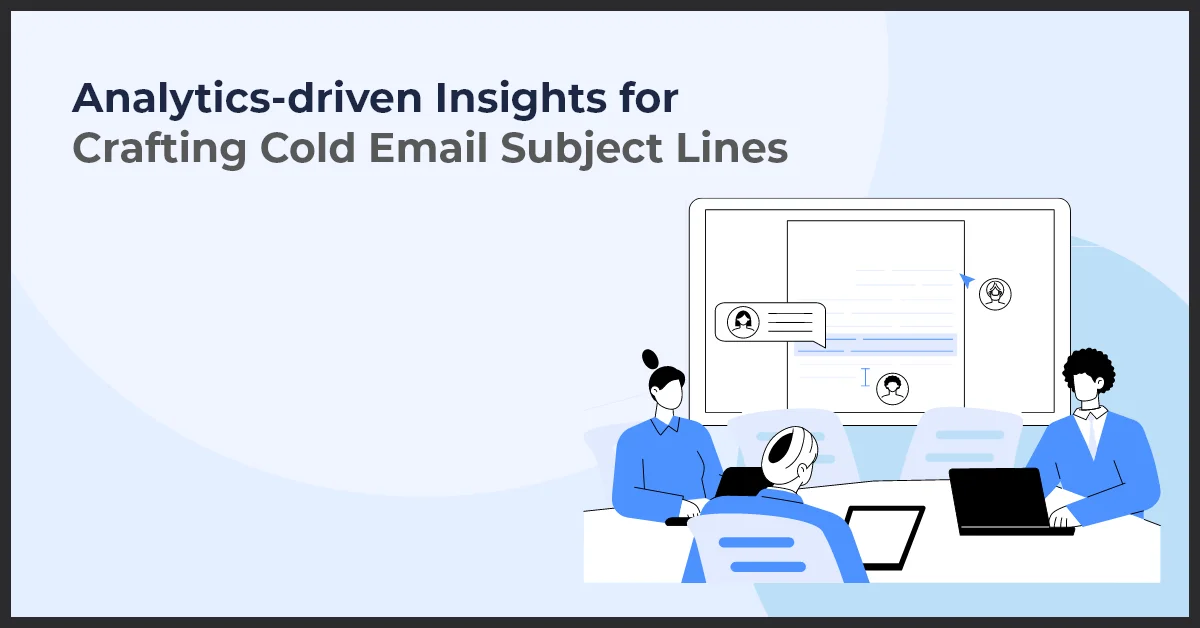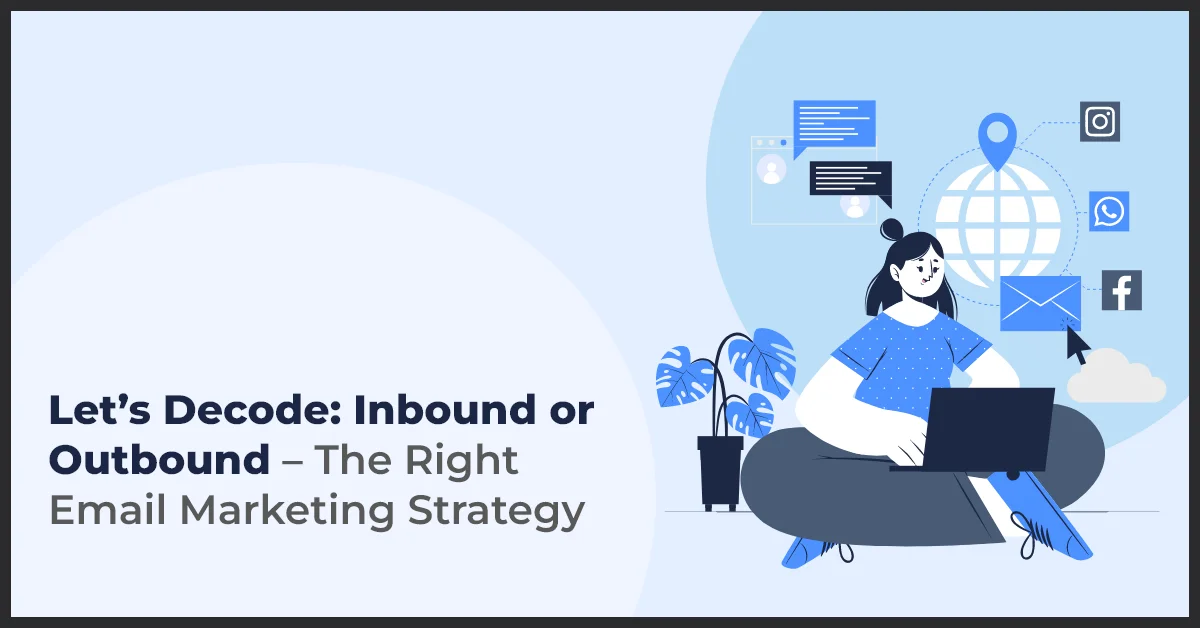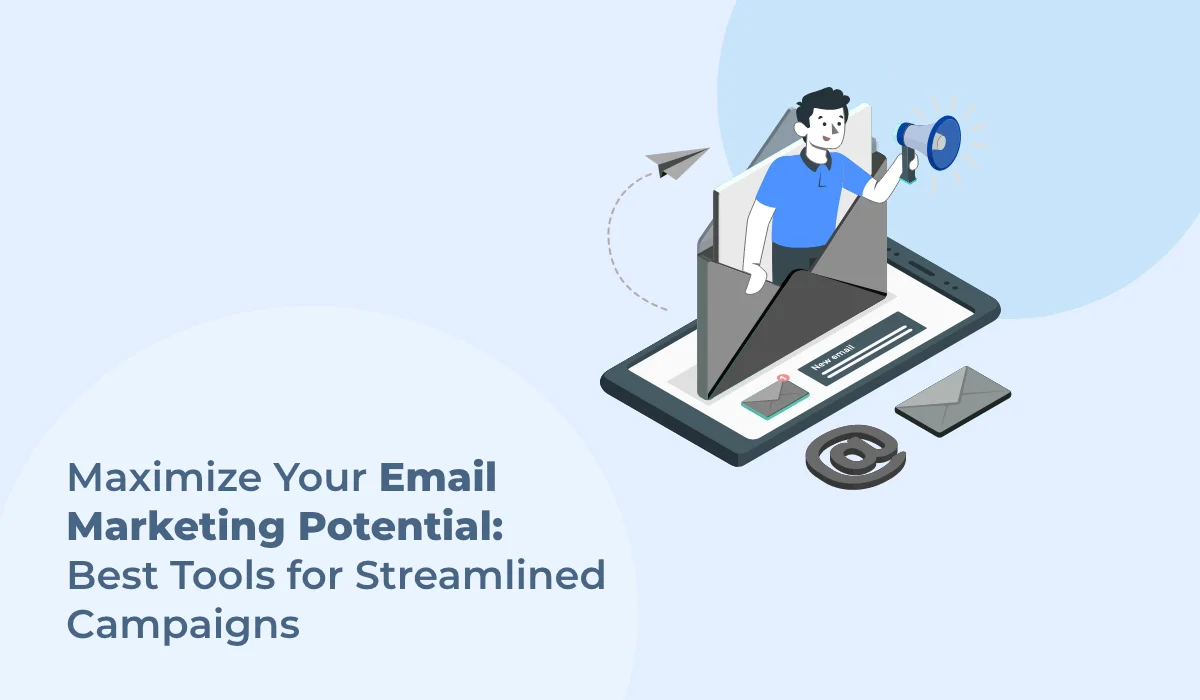The Power of Email Marketing: Strategies to Boost Your Business

Published on: October 23, 2023
Updated on: April 30, 2025
4114 Views
- Email Marketing
15 min read
Email marketing is essential for modern businesses looking to connect with their audience effectively. In today's digital world, where people are constantly inundated with information, email marketing provides a direct and personal way to reach your customers. By leveraging this powerful strategy, businesses can nurture relationships, drive engagement, and ultimately increase sales.
So, what exactly is email marketing? In other words, it involves sending targeted email messages to a specific audience. The power of email marketing lies in its ability to help businesses communicate directly with their customers and prospects, delivering valuable content, special offers, or news straight to their inboxes.
How can email marketing boost your business?
Email marketing allows businesses to build strong customer relationships through targeted communication, personalized content, and regular engagement. It enhances brand loyalty, drives sales, and is a cost-effective way to nurture leads. Businesses can use strategies like segmentation, A/B testing, and automation to create tailored email campaigns that increase engagement and conversion rates, ultimately driving business growth.
Why is email marketing important for businesses?
The answer is twofold: reach and control. With email, you can reach many people simultaneously, ensuring your message is received by a wider audience. Moreover, unlike relying solely on social media algorithms or search engine rankings, email marketing gives you total control over how and when you communicate with your audience.
Integrating email marketing into your marketing strategy can bring significant benefits. Firstly, it allows you to build and nurture customer relationships, fostering loyalty and brand trust. Secondly, email marketing is cost-effective for driving conversions and generating qualified leads.
By tailoring your email campaigns to specific customer segments, you can deliver personalized content that resonates with individual needs and interests.
Whether you're a small startup or an established enterprise, incorporating email marketing into your overall marketing strategy is undoubtedly a game-changer. Connect with your audience more meaningfully, build lasting relationships, and drive your business forward with the power of email marketing.
Understanding the Audience for Email Marketing
When it comes to email marketing, understanding your audience is crucial for success. You need to know who you are targeting with your campaigns and how to tailor your messages to meet their needs and preferences. Here are key strategies to consider:
Defining the Target Audience for Your Email Campaigns
Before crafting your emails, you must clearly define your target audience. Determine who are the individuals most likely to be interested in your products or services. Consider factors such as demographics, interests, and needs. You can create more relevant and compelling email content with a clear picture of your target audience.
Segmenting Your Email List Based on Customer Demographics, Preferences or Behavior
Segmenting your email list allows you to send tailored messages to specific groups of subscribers. You can deliver more personalized and targeted content by organizing your audience based on demographics, preferences, or behavior.
For example, you can send different emails to first-time customers versus loyal ones or create segments based on specific interests or past purchases.
Personalization Techniques to Enhance Email Engagement and Relevancy
Personalization is critical to capturing the attention and interest of your email recipients. Use personalized subject lines, greetings, and content to make your emails more relevant and valuable. Consider using dynamic content that adapts to each recipient's preferences or past interactions. By personalizing your emails, you can increase engagement and drive conversions.
By understanding your audience and tailoring your emails accordingly, you can maximize the impact of your email marketing campaigns. Remember, your goal is to provide value and build a strong connection with your subscribers.
Building an Effective Email Marketing Campaign
Regarding email marketing, having a well-planned and executed campaign is essential for success. This section will explore important strategies and best practices for building an effective email marketing campaign.
Email List Building
One of the first steps in creating an effective email marketing campaign is to grow your email subscriber list. Here are some strategies to help you do that:
- Utilize pop-up forms or overlays on your website to capture visitor email addresses
- Offer gated content, such as e-books, whitepapers, or exclusive articles, to encourage sign-ups
- Create compelling landing pages with opt-in forms to attract new subscribers
Additionally, it's crucial to ensure permission-based email marketing. Here are some opt-in techniques:
- Use confirmed opt-in or double opt-ins to verify subscribers and prevent spam
- Provide clear information on what subscribers can expect to receive and how often
- Offer a straightforward and easy-to-use unsubscribe option in every email
Lastly, creating lead magnets and incentives can significantly boost sign-ups. Consider offering exclusive discounts, freebies, or access to limited-time promotions to entice potential subscribers.
Email Campaign Types
Understanding the different types of email campaigns will help you align them with your specific marketing goals. Some common email campaign types include:
- Promotional emails: used to promote products or services, announce sales or events
- Informational emails: provide valuable content, tips, or industry news
- Transactional emails: confirm purchases, send order updates, or provide receipts
To create compelling and engaging email content, consider the following best practices:
- Personalize emails with the recipient's name, location, or past interactions
- Write concise and compelling subject lines to grab attention
- Include clear and prominent calls-to-action to encourage click-throughs
Email Templates and Design
Utilizing branded email templates helps maintain consistent brand messaging. Consider the following design best practices:
- Use a consistent color palette, fonts, and imagery that aligns with your brand identity
- Ensure your emails are responsive and visually appealing across different devices
- Optimize your email layouts for easy readability and navigation on small screens
Email Automation
Email automation can save you time and improve campaign efficiency. Here's how to get started:
- Set up automated email campaigns triggered by specific customer behaviors or actions
- Create email workflows to nurture leads and guide them through the sales funnel
- Segment your email list based on customer preferences, demographics, or purchase behavior
A/B Testing and Conversion Optimization
A/B testing is crucial in improving email marketing performance. Consider testing the following elements:
- Subject lines: test different variations to see which ones generate higher open rates
- Call-to-action buttons: experiment with different colors, wording, or placement
- Visuals: test additional images or graphics to see which ones drive more engagement
Additionally, strategies should be implemented to optimize email conversion rates and increase click-throughs. This may include optimizing landing pages, improving email copywriting, or streamlining checkout processes.
Monitoring and Analyzing Email Performance
To ensure the success of your email marketing campaigns, it is crucial to monitor and analyze your emails' performance continuously. You can refine your strategies and optimize your email marketing efforts by tracking key email metrics, utilizing email analytics tools, and analyzing engagement data.
Key Email Metrics to Track
There are several essential email metrics that you should track to gauge the performance of your campaigns:
- Open rates: This metric measures the percentage of recipients who open your emails. It provides insights into the effectiveness of your subject lines and email content.
- Click-through rates: These indicate the percentage of recipients clicking links within your emails. Higher click-through rates mean strong call-to-actions and compelling content.
- Conversion rates: Conversion rates measure the percentage of recipients who complete a desired action, such as purchasing or filling out a form. This metric helps assess the overall effectiveness of your email campaigns in driving desired outcomes.
Using Email Analytics Tools to Measure Campaign Effectiveness
Utilizing email analytics tools is essential to gain deeper insights into your marketing performance. These tools provide valuable data and metrics that can help you evaluate the effectiveness of your campaigns.
They offer comprehensive reports on open rates, click-through rates, conversion rates, and other vital metrics. By leveraging these tools, you can identify trends, patterns, and areas for improvement.
Analyzing Engagement Data to Refine Email Marketing Strategies
Analyzing engagement data lets you understand how your audience interacts with your emails. By examining metrics such as click heatmaps, time spent on emails, and subscriber behavior, you can identify areas of interest and tailor your email content to align with your audience's preferences.
This data-driven approach enables you to refine your email marketing strategies and deliver more relevant and engaging content, ultimately improving campaign performance.
Overcoming Email Deliverability Challenges
Regarding email marketing, one of the biggest challenges is ensuring that your emails reach your intended recipients' inboxes. This section will discuss strategies to overcome email deliverability challenges and get your messages in front of your audience.
Understanding Spam Filters And Avoiding Email Deliverability Issues
Email providers employ spam filters to protect users from unsolicited and malicious emails. To ensure your emails bypass these filters, follow these best practices:
- Use a reputable email service provider: Choose an email service provider with a good reputation and a clean sender score.
- Authenticate your emails: Implement Sender Policy Framework (SPF), DomainKeys Identified Mail (DKIM), and Domain-based Message Authentication, Reporting, and Conformance (DMARC) to verify the authenticity of your emails and increase deliverability.
- Avoid trigger words: Certain words and phrases can trigger spam filters. Steer clear of using terms like "free," "guaranteed," or "urgent" excessively.
- Optimize email design: Use a clean and straightforward layout with a good balance of text and images. Avoid using excessive HTML tags or large attachments that may flag your emails as suspicious.
Best Practices For Improving Email Deliverability Rates
To improve your email deliverability rates, consider these best practices:
- Keep your email list clean: Regularly remove invalid email addresses and unsubscribe requests to maintain a high-quality email list.
- Build engagement: Encourage recipients to open and interact with your emails by crafting compelling subject lines and personalized content.
- Segment your audience: Tailor your emails to specific segments of your audience to enhance relevancy and engagement.
- Perform regular testing: Test your emails across different email clients and devices to ensure optimal rendering.
Compliance With Email Marketing Regulations
To avoid legal issues and maintain the trust of your subscribers, adhere to email marketing regulations such as the CAN-SPAM Act and GDPR. Follow these guidelines:
- Provide clear unsubscribe options: Include an easy-to-find unsubscribe link in every email and promptly honor unsubscribe requests.
- Obtain explicit consent: Ensure you have explicit consent from subscribers before sending them marketing emails, especially with GDPR in place.
- Include a physical address: Include your physical mailing address in every email to comply with the CAN-SPAM Act.
Enhancing Email Engagement and Effectiveness
The subject line is one of the most essential parts of an email marketing campaign. It's the first thing your subscribers see in their inbox, which can significantly impact whether they open your email. To improve open rates, consider the following techniques:
- Keep it concise and clear: Your subject line should be short and to the point. Use action verbs and engaging language to entice readers to open your email.
- Create a sense of urgency: Incorporate words that convey a time-sensitive offer or limited availability. This can compel subscribers to open your email right away.
- Personalize it: Use your recipient's name or other personalized information to make the subject line feel more tailored to them. This can help grab their attention and increase open rates.
- Avoid spam trigger words: Stay away from keywords that are commonly associated with spam. These words can land your email in the spam folder and decrease open rates.
- Test and analyze: Experiment with different subject lines and monitor the open rates. Analyze the results to gain insights into what resonates with your audience and adjust your approach accordingly.
Using Compelling Content And Storytelling To Engage Subscribers
Content is critical when it comes to engaging and retaining email subscribers. By using compelling content and incorporating storytelling techniques, you can captivate your audience and keep them returning for more. Consider the following strategies:
- Know your audience: Understand your subscribers and tailor your content to their interests and needs. This will make your emails more relevant and engaging.
- Deliver value: Provide subscribers with valuable information, exclusive offers, or educational content. This will establish your expertise and build trust with your audience.
- Use storytelling techniques: Weave stories into your emails to captivate your readers. Storytelling can evoke emotions, create connections, and make your content more memorable.
- Include visuals: Incorporate eye-catching visuals such as images, videos, or infographics to break up the text and make your emails more visually appealing.
- Encourage interaction: Include calls-to-action encouraging subscribers to reply, share, or provide feedback. This fosters engagement and creates a dialogue with your audience.
Strategies For Increasing Click-Through Rates And Achieving Desired Actions
Getting subscribers to open your emails is one thing, but getting them to take the desired actions is another challenge. To increase click-through rates and drive conversions, employ the following strategies:
- Create clear and compelling calls-to-action: Make your desired action clear, concise, and prominent within your email. Use persuasive language and design elements to entice subscribers to click.
- Segment your audience: Divide your subscribers into specific segments based on their interests or behaviors. This lets you personalize your email content and calls to action, increasing relevance and click-through rates.
- Provide incentives: Offer exclusive discounts, freebies, or rewards to encourage subscribers to click and take action. Incentives can create a sense of urgency and motivate recipients to act.
- Optimize for mobile: Ensure your emails are mobile-friendly and display appropriately on different devices. A seamless mobile experience improves user engagement and increases the likelihood of click-throughs.
- Test and optimize: Continuously test different elements of your emails, such as layout, design, placement of calls-to-action, and wording. Analyze the results and optimize your approach to maximize click-through rates.
Integrating Email Marketing into a Comprehensive Marketing Strategy
Email marketing plays a crucial role in creating a successful marketing strategy. It not only helps in reaching out to the target audience directly but also complements other marketing channels. Let's explore how integrating email marketing enhances the overall effectiveness of your marketing strategy.
Aligning Email Marketing with Other Marketing Channels
Email marketing works hand in hand with various marketing channels, such as social media and content marketing. You can create a seamless experience for your audience by aligning these channels. For instance, you can use social media platforms to promote email newsletters and encourage sign-ups. In contrast, email marketing can be used to share content, updates, and exclusive offers. This integration ensures consistent messaging across multiple platforms and maximizes brand visibility and engagement.
Synergistic Approaches for Sales and Branding Efforts
Email marketing is a powerful tool for both sales and branding efforts. You can nurture leads, build relationships, and ultimately drive sales conversions by leveraging email campaigns. Additionally, email marketing allows you to establish and reinforce your brand identity. Consistent email branding helps create a strong brand image and promotes trust among your subscribers. By incorporating email marketing into your comprehensive marketing strategy, you can achieve a synergy that supports your sales and branding objectives.
Leveraging Customer Data to Enhance Overall Marketing Strategies
One of the key benefits of email marketing is the wealth of customer data it generates. Every email campaign provides valuable insights into your audience's preferences, behavior, and engagement. By analyzing this data, you can better understand your customers and tailor your overall marketing strategies accordingly. For example, you can use the data gathered from email campaigns to segment your audience and personalize your content across other marketing channels. This targeted approach significantly boosts the effectiveness of your marketing efforts.
Final Thoughts
In conclusion, effective email marketing has proven a powerful tool for businesses to reach their audience and drive results. Throughout this guide, we have covered various aspects and benefits of email marketing. Let's recap:
- Understanding the Audience: Email marketing allows businesses to target specific audience segments and tailor their messaging accordingly.
- Building an Effective Campaign: By following best practices, businesses can create engaging and personalized email campaigns that resonate with their audience.
- Monitoring and Analyzing Performance: Through email analytics, businesses can track the success of their campaigns and make data-driven decisions to optimize future efforts.
- Overcoming Deliverability Challenges: Businesses can ensure their messages reach the intended recipients by focusing on email deliverability best practices.
- Enhancing Engagement and Effectiveness: Engaging email content, strategic segmentation, and personalization can significantly improve email engagement and overall effectiveness.
- Integrating Email Marketing: By incorporating email marketing into a comprehensive marketing strategy, businesses can amplify the impact of their campaigns and achieve better results across channels.
As for the future of email marketing, we anticipate emerging trends such as increased personalization, interactive content, and automation to enhance the effectiveness and engagement of email campaigns. Businesses must stay updated with these trends and adapt their strategies to stay ahead of the competition.
Next Steps?
Create and nurture effective email marketing campaigns with a trusted partner. At Growth Natives, we offer the expertise that helps you streamline your email marketing campaigns while optimizing your CRM instance.
Learn more about our services by emailing us at info@growthnatives.com or visiting our website today!
Frequently Asked Questions
Email marketing boosts business growth by nurturing leads, driving sales, enhancing customer retention, and promoting brand awareness through targeted, personalized, and cost-effective communication.
The strategic use of email marketing involves segmenting your audience, personalizing content, automating campaigns, analyzing performance metrics, and optimizing based on data to maximize engagement and conversion rates.
Email campaigns send targeted, relevant messages to a segmented list of recipients, aiming to achieve specific goals like lead nurturing, sales conversion, or customer retention through compelling content and a call to action.
- Define Goals: Set clear objectives.
- Build a List: Segment your audience.
- Craft Content: Write engaging subject lines and email copy.
- Design: Create visually appealing templates.
- Automate: Set up automation and triggers.
- Test: A/B test elements.
- Send: Launch the campaign.
- Analyze: Measure performance and optimize.
Email marketing is used because it is cost-effective, highly targeted, and provides measurable results, enabling businesses to reach and engage their audience, drive conversions, and build long-term customer relationships.



